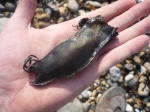About
The documented traits include three different types:
- biological and ecological traits-specific characteristics of a taxon (e.g. body size or feeding type)
- taxonomic traits (e.g. paraphyletic groups)
- human-defined traits (e.g. Red List species)
Based on the criteria of applicability across most taxa, availability for most species, and potential usage, 10 traits have been prioritized within EMODnet Biology.
Criteria for selecting traits were that they could be applied to most taxa, were easily available, and their inclusion would result in
new research and/or management applications.
| Trait |
Relevance |
| Taxonomy (*) |
Related species have similar traits, so taxonomic relationships can predict traits of related species |
| Environment (*) |
Most studies are confined to a particular environment, so this traits allows users to quickly isolate species of interest for their purpose |
| Geography (*) |
Distribution is the most sought after information on species, after their taxonomy |
| Depth |
The most widely available variable to distinguish species' habitat |
| Body-size |
Related to position in feed webs, species abundance, metabolic rates and dispersal |
| Substratum |
A key physical factor determining species habitat |
| Mobility |
Indicates the dispersal potential of the life-stage |
| Skeleton |
Calcareous important for ocean acidification and fossil record |
| Diet |
Influence on abundance of other species & determines the position in the food web |
| Reproduction |
May relate to the ability of a population to recover from reduced abundance or invisibility |
(*) Taxonomy and environment related information is pulled from the World Register of marine Species (WoRMS),
whereas geography data are available through the Ocean Biodiversity Information System (OBIS).
In addition, the 'status' of species for conservation, whether introduced or invasive, of
fishery or aquaculture interest, harmful, or used as an ecological indicator, are reviewed because these attributes are of particular
interest to society.
All species trait and attribute information is stored in the Aphia database, the database behind the World Register of Marine Species
(WoRMS).
The traits hierarchy and definitions for each trait are managed through a WIKI, specifically set up for marine species traits.
The traits portal is part of the LifeWatch Species Information Backbone
and the biology project of the European Marine Observation and Data Network
(EMODnet Biology). The utility and availability of traits for marine species in the framework of EMODnet Biology has been thoroughly
described in the following paper: Biological and ecological traits of marine species.
|




























